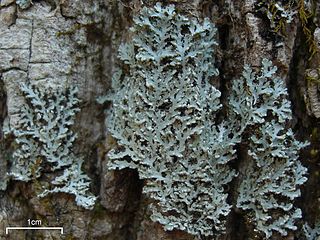
Usnea is a genus of mostly pale grayish-green fruticose lichens that grow like leafless mini-shrubs or tassels anchored on bark or twigs. The genus is in the family Parmeliaceae. It grows all over the world. Members of the genus are commonly called old man's beard, beard lichen, or beard moss.

Rock tripe is the common name for various lichens of the genus Umbilicaria that grow on rocks. They are widely distributed, including on bare rock in Antarctica, and throughout northern parts of North America such as New England and the Rocky Mountains. They are edible when properly prepared; soaking extensively and boiling with changes of water removes the bitterness and purgative properties. They have been used as a famine food in extreme cases when other food sources were unavailable, as by early American northern explorers.

The Parmeliaceae is a large and diverse family of Lecanoromycetes. With over 2700 species in 71 genera, it is the largest family of lichen-forming fungi. The most speciose genera in the family are the well-known groups: Xanthoparmelia, Usnea, Parmotrema, and Hypotrachyna.

Ramalina is a genus of greenish fruticose lichens that grow in the form of flattened, strap-like branches. Members of the genus are commonly called strap lichens or cartilage lichens. Apothecia are lecanorine.

Heterodermia is a genus of lichenized fungi in the family Physciaceae. The genus has a widespread distribution, especially in tropical regions, and contains about 80 species.

Allocetraria is a genus of lichenized fungi in the family Parmeliaceae. It consists of 12 species, with a center of distribution in China.

Hypogymnia is a genus of foliose lichens in the family Parmeliaceae. They are commonly known as tube lichens, bone lichens, or pillow lichens. Most species lack rhizines that are otherwise common in members of the Parmeliaceae, and have swollen lobes that are usually hollow. Other common characteristics are relatively small spores and the presence of physodic acid and related lichen products. The lichens usually grow on the bark and wood of coniferous trees.

Melanelixia is a genus of foliose lichens in the family Parmeliaceae. It contains 15 Northern Hemisphere species that grow on bark or on wood. The genus is characterized by a pored or fenestrate epicortex, and the production of lecanoric acid as the primary chemical constituent of the medulla. Melanelixia was circumscribed in 2004 as a segregate of the related genus Melanelia.

Cetrelia is a genus of leafy lichens in the large family Parmeliaceae. They are commonly known as sea-storm lichens, alluding to the wavy appearance of their lobes. The name of the genus, circumscribed in 1968 by the husband and wife lichenologists William and Chicita Culberson, alludes to the former placement of these species in the genera Cetraria and Parmelia.

Punctelia is a genus of foliose lichens belonging to the large family Parmeliaceae. The genus, which contains about 50 species, was segregated from genus Parmelia in 1982. Characteristics that define Punctelia include the presence of hook-like to thread-like conidia, simple rhizines, and point-like pseudocyphellae. It is this last feature that is alluded to in the vernacular names speckled shield lichens or speckleback lichens.
Protousnea is a genus of lichenised ascomycetes in the large family Parmeliaceae. It contains two accepted species. Protousnea species have a fruticose growth form, similar to beard lichens. The genus is endemic to southern South America. The genus was circumscribed in 1976 by Hildur Krog as a segregate genus from Usnea.

Bryoria is a genus of lichenized fungi in the family Parmeliaceae. Many members of this genus are known as horsehair lichens. The genus has a widespread distribution, especially in boreal and cool temperate areas.
Lethariella cladonioides, locally known as lu xin xue cha or hong xue cha, is a fruticose lichenized species of fungus in the family Parmeliaceae. It is distributed throughout Southwest and Northwest China, India, Nepal, Pakistan, and Kashmir. It is used as traditional medicine and health-promoting tea in China for treatment and prevention of sore throats, high blood pressure, inflammation, dizziness and neurasthenia.
Melanohalea subverruculifera is a species of lichen in the family Parmeliaceae. Found in China, it was first formally described as a new species in 1980 as Parmelia subverruculifera. It was transferred to the segregate genus Melanelia in 1991, and then to the genus Melanohalea in 2004.
Punctelia negata is a little-known species of foliose lichen in the family Parmeliaceae. It is found in South America.

Usnocetraria is a genus of foliose lichens in the family Parmeliaceae.

Philippe Clerc is a Swiss lichenologist. A Festschrift was dedicated to him in 2020, on the occasion of his retirement from the Conservatory and Botanical Garden of the City of Geneva, where he worked from 1993 to 2020. Clerc is an authority on the beard lichens, and has had nearly 100 publications on this and other topics, such as the lichen flora of Switzerland.
Lethariella cashmeriana is a species of fruticose lichen in the family Parmeliaceae. It was formally described as a new species in 1976 by Hildur Krog. The species epithet cashmeriana refers to Jammu-Kashmir, where the type specimen was collected. The lichen is one of three species of Lethariella that is used as a purported health-promoting tea in Yunnan, China. It contains atranorin, canarione, gyrophoric acid, and norstictic acid (minor) as lichen products.
Lethariella sinensis is a species of fruticose lichen in the family Parmeliaceae. It was formally described as a new species in 1982 by Chinese lichenologists Jiang-Chun Wei and Yu-Mei Jiang. The type specimen was collected from Qamdo at an altitude of 4,300 m (14,100 ft); there, it was found growing on the branch of Thuja. It is an orange, long pendant lichen with a reticulate surface. In 2001, Walter Obermayer showed that the holotype specimen of Lethariella sinensis comprised two chemically unique taxa: one with psoromic acid and the other with norstictic acid. The former was chosen as the lectotype, and as a consequence, Lethariella mieheana became synonymous with L. sinensis.













